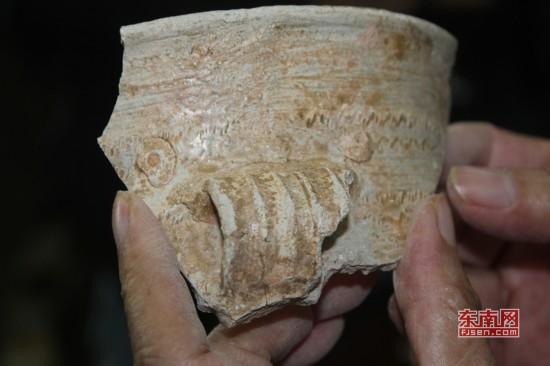Information
The Earliest Kiln Site of Proto-Porcelain found in Quanzhou, Fujian Province
Summary: The Quanzhou Kiln site of proto-porcelain included Kuzhaikeng kiln and Liaotianjianshan kiln, while the distance between them was 200 meters.The kiln site was found in the early 2007, which was considered as remains of kiln furnace and conducted archaeolo
The Quanzhou Kiln site of proto-porcelain included Kuzhaikeng kiln and Liaotianjianshan kiln, while the distance between them was 200 meters.
The kiln site was found in the early 2007, which was considered as remains of kiln furnace and conducted archaeological investigation twice. From October to November in 2014, Liaotianjianshan Kiln was excavated, the excavation area reached 50 square meters, and 4 kiln faurnace remains were discovered. From November 2015 to January 2016, two proto-porcelain kiln site of Liaotianjianshan and Kuzhaikeng were excavated. Kiln Y5 to Y8, the four kilns furnace remains were found in Liaotianjianshan. The excavation area reached 235 square meters in Kuzhaikeng proto-porcelain kiln site, 9 kiln furnaces were found.
The twice archaeological excavations achieved great significance in kiln furnace remains and unearthed cultural relics. Besides, during the excavation, archaeological investigation was conducted around hills, many coeval kilns were discovered as well.
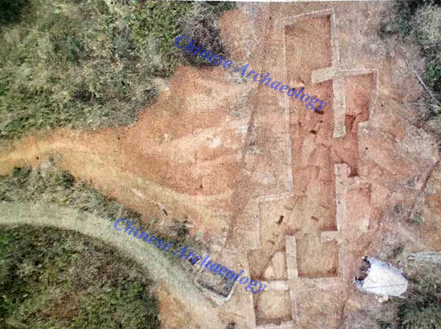
The aerial photo of Kuzhaikeng proto-porcelain kiln
Kiln furnace remains
The twice archaeological excavations found 17 proto-porcelain kiln furnace remains, 8 of which were belonged to Liaotianjianshan Site, while 9 were belonged to Kuzhaikeng Site. 9 kiln furnace remains were excavated completely. The similarities and differences were listed below:
Similarities: They all belonged to dragon kiln, which was consisted of a fire box and a chamber, 4 meters in length and 1 meter in width. The kiln was built up along the hill, which was intensively distributed.
Differences: The floor of Liaotianjianshan proto-porcelain kiln’s obliquity was relatively high, which was 23° to 26°; the thickness of the kiln wall was about 6 to 8 cm; the plan of fire box wall presented as circle or perpendicular; every kiln only possessed one layer of working surface in the fire place; few remains was unearthed, while the porcelain body was strong with various decoration, and the pattern was rich.
The floor of Kuzhaikeng proto-porcelain kiln’s obliquity was low, about 5° to 15°; the thickness of the kiln wall was thin, about 2 to 5 cm; firebox wall was in two shapes, circle or convex shaped; there were 2 to 4 layers of the working surface in firebox, 7 layers at most; plenty of wares were unearthed, while the porcelain body was soft and loose. Many of them without decoration and the pattern were simple.

The general view of Liaotianjianshan proto-porcelain kiln during its first excavation
Unearthed wares
The twice archaeological excavation unearthed plenty of proto-porcelain, few black pottery, and one stone dagger-axe as well. Mainly were broken pieces. According to the shape of the pieces, it could be divided into two types, daily utensils and kiln furniture.
The daily utensils’ types were vessel Zhun, jar, bowl, vessel Dou, as well as pottery spindle whorls, etc. The kiln furniture was spacers and very seemingly scraper pieces. The glaze presented as greenish grey and turquoise, partially was little brownish or yellowish. The decoration methods were carving, printing, stamping, pasting, and hollowing etc, while the pattern were bow-string, fishing-net, cord, cloud and thunder and ripple etc.
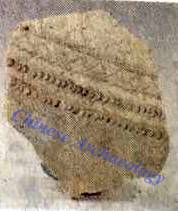
The shoulder part of a ware
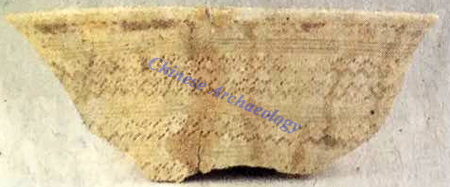
Mouth rim of Zun vesselNew discoveries
During the excavation, the archaeological team conducted investigation on the two sites of Liaotianjianshan and Kuzhaikeng, figuring out the scale of the sites. Besides, the investigation covered the hills around, discovered 3 proto-porcelain site, collected some samples, the cultural characteristics of which was similar to the two proto-porcelain kiln sites of Liaotianjianshan and Kuzhaikeng.
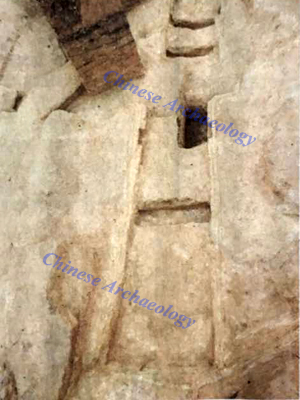
Part of the furnace remain of Kuzhaikeng proto-porcelain kiln
Chronological analysis
Before the result of C14 test, the judging of the age was according to the archaeological data comparison between Fujian province and Zhejiang, Jiangxi, etc, the adjacent provinces. Based on Fujian area’s archaeological investigation and related materials, as well as the comparison of the kiln nature and unearthed wares, Quanzhou proto-porcelain kiln site was about Shang to Zhou Dynasty.
Significance
The excavation of Quanzhou proto-porcelain kiln site was significant. First of all, it was the earliest kiln site of proto-porcelain in Fujian Province, the discovery of which pushed producing history of Quanzhou porcelain 1000 years earlier. Secondly, the unearthed proto-porcelain sample possessed distinctive regional characteristics, which had great difference in the local area, establishing its own system. Last, Quanzhou proto-porcelain kiln site excavated many dragon kilns with complete structure and well preserved proto-porcelain sample, which provided important materials for the study of structure, kiln technique and proto-porcelain development of Shang and Zhou Dynasty. (Translator: Lang Langtian)
The kiln site was found in the early 2007, which was considered as remains of kiln furnace and conducted archaeological investigation twice. From October to November in 2014, Liaotianjianshan Kiln was excavated, the excavation area reached 50 square meters, and 4 kiln faurnace remains were discovered. From November 2015 to January 2016, two proto-porcelain kiln site of Liaotianjianshan and Kuzhaikeng were excavated. Kiln Y5 to Y8, the four kilns furnace remains were found in Liaotianjianshan. The excavation area reached 235 square meters in Kuzhaikeng proto-porcelain kiln site, 9 kiln furnaces were found.
The twice archaeological excavations achieved great significance in kiln furnace remains and unearthed cultural relics. Besides, during the excavation, archaeological investigation was conducted around hills, many coeval kilns were discovered as well.

The aerial photo of Kuzhaikeng proto-porcelain kiln
Kiln furnace remains
The twice archaeological excavations found 17 proto-porcelain kiln furnace remains, 8 of which were belonged to Liaotianjianshan Site, while 9 were belonged to Kuzhaikeng Site. 9 kiln furnace remains were excavated completely. The similarities and differences were listed below:
Similarities: They all belonged to dragon kiln, which was consisted of a fire box and a chamber, 4 meters in length and 1 meter in width. The kiln was built up along the hill, which was intensively distributed.
Differences: The floor of Liaotianjianshan proto-porcelain kiln’s obliquity was relatively high, which was 23° to 26°; the thickness of the kiln wall was about 6 to 8 cm; the plan of fire box wall presented as circle or perpendicular; every kiln only possessed one layer of working surface in the fire place; few remains was unearthed, while the porcelain body was strong with various decoration, and the pattern was rich.
The floor of Kuzhaikeng proto-porcelain kiln’s obliquity was low, about 5° to 15°; the thickness of the kiln wall was thin, about 2 to 5 cm; firebox wall was in two shapes, circle or convex shaped; there were 2 to 4 layers of the working surface in firebox, 7 layers at most; plenty of wares were unearthed, while the porcelain body was soft and loose. Many of them without decoration and the pattern were simple.

The general view of Liaotianjianshan proto-porcelain kiln during its first excavation
Unearthed wares
The twice archaeological excavation unearthed plenty of proto-porcelain, few black pottery, and one stone dagger-axe as well. Mainly were broken pieces. According to the shape of the pieces, it could be divided into two types, daily utensils and kiln furniture.
The daily utensils’ types were vessel Zhun, jar, bowl, vessel Dou, as well as pottery spindle whorls, etc. The kiln furniture was spacers and very seemingly scraper pieces. The glaze presented as greenish grey and turquoise, partially was little brownish or yellowish. The decoration methods were carving, printing, stamping, pasting, and hollowing etc, while the pattern were bow-string, fishing-net, cord, cloud and thunder and ripple etc.

The shoulder part of a ware

Mouth rim of Zun vessel
During the excavation, the archaeological team conducted investigation on the two sites of Liaotianjianshan and Kuzhaikeng, figuring out the scale of the sites. Besides, the investigation covered the hills around, discovered 3 proto-porcelain site, collected some samples, the cultural characteristics of which was similar to the two proto-porcelain kiln sites of Liaotianjianshan and Kuzhaikeng.

Part of the furnace remain of Kuzhaikeng proto-porcelain kiln
Chronological analysis
Before the result of C14 test, the judging of the age was according to the archaeological data comparison between Fujian province and Zhejiang, Jiangxi, etc, the adjacent provinces. Based on Fujian area’s archaeological investigation and related materials, as well as the comparison of the kiln nature and unearthed wares, Quanzhou proto-porcelain kiln site was about Shang to Zhou Dynasty.
Significance
The excavation of Quanzhou proto-porcelain kiln site was significant. First of all, it was the earliest kiln site of proto-porcelain in Fujian Province, the discovery of which pushed producing history of Quanzhou porcelain 1000 years earlier. Secondly, the unearthed proto-porcelain sample possessed distinctive regional characteristics, which had great difference in the local area, establishing its own system. Last, Quanzhou proto-porcelain kiln site excavated many dragon kilns with complete structure and well preserved proto-porcelain sample, which provided important materials for the study of structure, kiln technique and proto-porcelain development of Shang and Zhou Dynasty. (Translator: Lang Langtian)
Category: English
News
Information
Key words:

